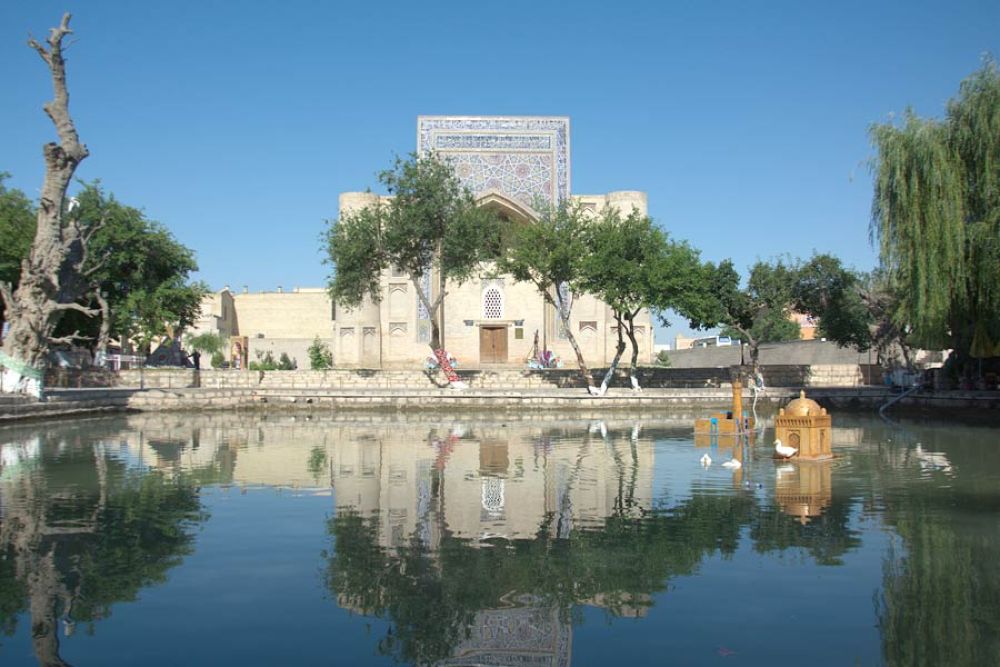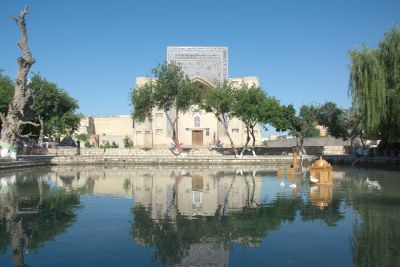

The Kukeldash Madrasah, dating back to the 16th century, is an architectural marvel located at Lyabi-Hauz. It is one of the largest Islamic schools in Central Asia. Visitors can admire the intricate tile work and grand facades that speak volumes of the historic Persian architecture. Inside, the madrasah features a mosque, a courtyard, and dormitory rooms that once housed students. Exploring the massive structure, you get a sense of the scholastic life that dominated the area centuries ago. Regular exhibitions and craft workshops conducted inside the madrasah offer an immersive experience into the cultural heritage of Uzbekistan. Though it’s no longer functional as a school, the Kukeldash Madrasah stands as a testament to Bukhara's historical importance as a center for Islamic learning and culture.
After exploring the historical sights around Lyabi-Hauz, savor traditional Uzbek cuisine at one of the surrounding restaurants. These eateries offer a unique dining experience with tables set around the ancient water reservoir, providing tranquil views. Guests can enjoy dishes such as plov (a local rice dish), shashlik (kebabs), and a variety of regional soups and salads. The restaurants also typically feature live local music, enhancing the ambiance as you dine under the Uzbek sky. The combination of delicious food, cultural music, and historic setting makes for an enchanting evening. In addition to the excellent fare, many of these dining spots offer lessons in local culinary arts for visitors interested in learning to cook traditional dishes.
The Lyabi-Hauz ensemble serves not only as a reminder of the past but also as a stage for cultural performances. Enrich your travel experience by attending a traditional folklore show, which often takes place around the hauz, or pond. These shows exhibit colorful dances, vibrant costumes, and melodious music that are integral to Uzbek culture. Folklore performances provide a glimpse into local customs and traditions that have been passed down through generations. The experience is both educational and entertaining, suitable for all ages. The performances typically highlight various aspects of Uzbek life, from daily routines to festive celebrations, giving onlookers a multifaceted view of Uzbek culture.
Situated right by the Lyabi-Hauz pond, the Nadir Divanbegi Madrasah is an iconic landmark of Bukhara. Originally built as a caravanserai in the 17th century, it was later converted into a madrasah due to its popularity with religious scholars. The facade of the building is decorated with stunning mosaics depicting birds and flora, which is somewhat unconventional for Islamic architecture. As you step inside, you are greeted by a large courtyard surrounded by intricate arches and student cells that have now been turned into shops selling local handicrafts and souvenirs. Visitors are often enthralled by the rich history and artistic grandeur of the madrasah, making it an essential stop for anyone interested in the culture and artistry of Uzbekistan.
No trip to Bukhara is complete without a visit to the bustling bazaars near Lyabi-Hauz. These markets offer a sensory overload with their myriad of spices, colorful textiles, intricate jewelry, and traditional crafts. Exploring the bazaar is a delight for shoppers and culture enthusiasts alike. Here, you can purchase embroidered suzani textiles, hand-painted ceramics, and even beautifully crafted metalwork. As you navigate the vibrant stalls and interact with the friendly vendors, you'll gain insights into the local way of life and traditions. Haggling is common, so be prepared to negotiate to get the best deals on unique souvenirs that capture the essence of Uzbekistan.
The Lyabi-Hauz pond is a serene oasis in the middle of the bustling city. Surrounded by ancient buildings, it provides a peaceful place to relax and reflect after a day of sightseeing. The pond is one of the few remaining hauzes, or water reservoirs, that once were plentiful in the city of Bukhara. Lined by mulberry trees and filled with the soft sounds of the city, it’s the perfect spot for travelers to rest and watch the world go by. Often, you might encounter local artisans displaying their wares or musicians playing traditional tunes, adding to the tranquil atmosphere. As the sun sets, the water reflects the changing colors of the sky, making for a picturesque scene that is loved by photographers and romantics alike.
The Bukhara State Museum, within walking distance of the Lyabi-Hauz ensemble, offers a deep dive into the region's rich history. As one of the oldest museums in Uzbekistan, it hosts a wealth of artifacts ranging from ancient coins and pottery to traditional costumes and manuscripts. Wandering through the museum's halls, visitors can trace the evolution of Bukharan culture from its pre-Islamic times through the Mongol invasion and the Silk Road era up to modern-day Uzbekistan. Each exhibit is meticulously curated to provide an educational journey that is both impressive and informative. This museum visit appeals to history buffs, art lovers, and curious travelers keen on understanding the backdrop against which the Lyabi-Hauz Ensemble came to be.
Tea is an essential part of Uzbek culture, and what better place to experience a traditional tea ceremony than near the historical Lyabi-Hauz ensemble. Several tea houses or 'chaikhanas' can be found in the vicinity, offering visitors a chance to savor authentic Uzbek tea. The ceremony often includes a wide variety of teas served with an array of sweets and pastries, like baklava and dried fruits. Participating in a tea ceremony is not only about drinking tea; it's an opportunity to immerse yourself in local customs and socialize with inhabitants. The hospitable chaikhana hosts will share stories and insights about Uzbek traditions, making this more than just a culinary experience—it's a cultural exchange.
A walking tour is a fantastic way to get acquainted with the rich tapestry of history that envelops the Lyabi-Hauz Ensemble and surrounding areas. Knowledgeable local guides can lead you through the maze of old city streets, pointing out significant landmarks and lesser-known gems along the way. You'll hear fascinating tales about the life and times of the merchants, scholars, and craftsmen who made Bukhara a key stop on the Silk Road. Highlights of the tour often include not just Lyabi-Hauz, but also the iconic Po-i-Kalyan complex, the Ark fortress, and the Chor-Minor Madrasah, each site replete with stories and architectural splendor. Such a tour is not just about seeing, but understanding the historical context that shaped the city.
A short walk from Lyabi-Hauz brings you to the picturesque Char Minar, a unique monument of Bukhara. With its four minarets and vibrant tiles, it offers an ideal spot for photography enthusiasts. The structure, which once stood at the gate of a long-gone madrasah, now stands out for its unusual design and bright blue adornments. Visitors can capture the essence of Bukharan Islamic architecture through their lens, with the Char Minar providing a photogenic backdrop that is distinctly different from the rest of the city's historical buildings. Whether you're a professional photographer or just enjoying snapping pictures on your phone, the Char Minar is a visual treat worth documenting.
